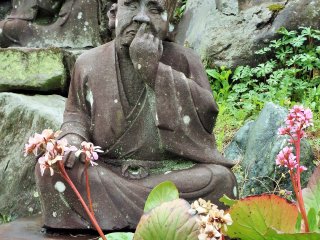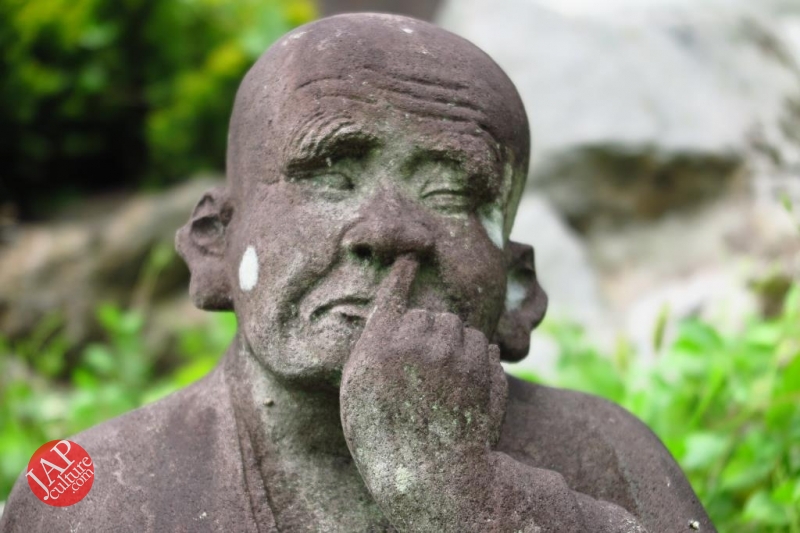AUDIO VERSION OF THIS ESSAY AVAILABLE HERE>>
Sometimes folks ask about moving and fixing during Zazen, when their legs fall asleep, or a mosquito tickles. How much should they tolerate, or try to ignore, and when is it okay to take action? My response to this actually goes far beyond just the times of sitting, and offers a powerful approach to living all of life, with all its difficulties, and maybe even to dealing with this world's biggest problems.

To begin, the Japanese have a wonderful word, Gaman (我慢), which means something like "bear with patience" or "put up with." There is certainly an aspect of that in Zazen sometimes. In Shikantaza, we sit with the attitude that "nothing is lacking," there is "nothing in need of repair" during the time of sitting, and we trust that Zazen is a complete experience just by sitting. We hold radical equanimity during the time of sitting, allowing all things in the universe to be just what they are. Such attitude is vital during Zazen. But, even so, it is a fact that sometimes our knees ache, or the doorbell rings or our nose itches, and it is hard to just sit there.
At that point, our first response should be doing our best to ignore the distraction, to not fixate on it, to leave it be. When we fixate, obsess and wallow in the feeling, we actually magnify its power and make it worse. Instead, do as you can not to fixate, to let it be and to place your attention elsewhere, such as on open space, your breath or even an inner mantra if your need. You may be surprised at the power of "mind over matter," our human ability to put up with even what seems impossible to bear when we do not allow the mind to cling and resist the situation. If the mind does not grab onto the feeling or emotions of rejection, the problem becomes just another object in the room where we sit, like an unobtrusive chair in the corner: The problem is there, but somehow does not loom as large before our eyes, seems smaller, or is actually forgotten.
But, even then, there may come a time when we really need to move, act and at least try to deal with the situation. When is that point, what is the proper time? Sorry, I cannot really answer that for you. You have to decide for yourself. However, what I can say is that, all throughout, whether you move or do not move, please have radical acceptance of the situation.
There are stories of ancient Zen Masters who kept sitting, still and peaceful inside, as poison snakes and wild tigers moved all around them, and it is actually a good idea to be so still and unmoving, in both body and mind, at such moments sometimes. I recall once sitting at Sojiji, the Soto monastery in Japan, when a big earthquake struck right during Zazen in a creaky, 150 year old building with a shaking heavy roof over our heads! But nobody moved, and I seemed to be the only one even to look around!
 I later asked one of the older Japanese members about this, and he said, "We are prepared to die in Zazen!"
I later asked one of the older Japanese members about this, and he said, "We are prepared to die in Zazen!"  Wow, that is the spirit! It is true that we should sit Zazen, dropping away all thoughts and fears of life and death.
Wow, that is the spirit! It is true that we should sit Zazen, dropping away all thoughts and fears of life and death.Of course, in my case, if the shaking had been just a little bigger, I think that I would have fled out the door, my Zafu cushion over my head!
 I am not ashamed of this. There does come a definite time to act: Do not risk injury to yourself. If it is 100 biting mosquitoes, or a rattle snake, or if the house is on fire, I advise you to take action. Don't Gaman the fire!
I am not ashamed of this. There does come a definite time to act: Do not risk injury to yourself. If it is 100 biting mosquitoes, or a rattle snake, or if the house is on fire, I advise you to take action. Don't Gaman the fire!  Light mosquito coils, move to a safer place, put out the fire. However, after doing so, please resume sitting in radical equanimity, forgetting life and death, while cross-legged atop the ashes of what was your house. If it be truly an emergency, really 'life or death,' answer the phone or door. If not, let them call again later. If you are having a heart attack, however, please pause Zazen, call the ambulance, then resume Zazen in the ambulance ... even if it is your last.
Light mosquito coils, move to a safer place, put out the fire. However, after doing so, please resume sitting in radical equanimity, forgetting life and death, while cross-legged atop the ashes of what was your house. If it be truly an emergency, really 'life or death,' answer the phone or door. If not, let them call again later. If you are having a heart attack, however, please pause Zazen, call the ambulance, then resume Zazen in the ambulance ... even if it is your last. 
Scratch your itch, adjust your posture, at a certain point. I cannot tell you exactly what that point is, and you must decide. However, do not then go to the other extreme, which is not good either: Do not start to wallow in the situation, changing your posture every 10 seconds, making the pain or annoyance the center of your life, becoming its puppet and prisoner. Instead, fix it a little, then let it go again! Fix, not fixate. Return as best you can to the Gaman, equanimity and non-attachment regarding the situation of 'Step 1.' Repeat from time to time, but not too much.
But there is a further step that is truly unique to Zazen, and different from our usual human way of encountering life:
Whether moving and fixing, or not moving and not fixing, maintain radical equanimity and acceptance throughout. It is an unusual kind of acceptance because, in fact, this is an acceptance so deep and underlying that we feel it BOTH at the times we accept things AND at the times we do not! In other words, it is feeling both profound acceptance and, sometimes, resistance and non-acceptance all at once. I do not mean that we simply accept that we do not accept some things sometimes, and tolerate the fact that sometimes we reject how life is (although that is important to do too, and we should be patient with ourselves when we are not having our best moments). Instead, what I describe is more like our having a two-chambered heart, with one chamber filled with overwhelming peace and equanimity, while the other chamber can be overflowing with rejection, disquiet, fear, resistance to a situation, upset, not liking it at all ... with both chambers beating together as one, pumping out a kind of "acceptance-non-acceptance, peace with disquiet, fearless-fear, resistance without resistance" which flows all through us as a single emotion. It is possible to encounter life in such seemingly incongruous ways at once, as one.
Furthermore, let the acceptance and equanimity side be strong, and do your best to keep the resisting and unhappy side burning low, like a fire that is not raging out of control. In fact, when the unpleasant emotions of non-acceptance and resistance blend with the power of acceptance and allowing, the negative emotions will tend to moderate and grow cooler naturally, all on their own.
Thus, please sit in Shikantaza Zazen, practicing the art of deep flowing with life, letting all "just be." Then, rising from the cushion, keep in your heart (as best you can) this same flowing and letting be always ... even at those times when the world seems more like a flood or Tsunami than a 'flowing,' and life just won't let you alone.
Such radical equanimity is especially important for those situations you cannot fix or control. It is a powerful force and, should the doctor ever tell you that you have a week to live with no hope for a cure, I hope you know peace and allowing all during that final week. Or, should you face other disaster, loss or threat you may not be able to escape, please learn to feel the acceptance of the universe that holds even that: Should a tiger chase you, please know tolerance even as you run for your life, sweat pouring from your brow, and please know that much greater tolerance should the tiger catch you, as it digs in its teeth!

Some romantic folks think that 'enlightenment' means such incredible peace and bliss that one is totally cool even with a robber's gun to one's head. Popular assumption is that people need to either accept or not accept a situation, or perhaps they can feel ambiguous or confused "mixed feelings." The Zen wisdom I propose is not that, but is rather totally cool even when hot, a complete, profound, thorough, existential welcoming, joy and embracing felt even as we might also be shaking in our boots, worried for tomorrow, pooping our pants. It is like knowing life with two eyes, one seeing only peace and beauty, one seeing a broken world ugly and scary, with both eyes open at once presenting the clear vision Eye of an enlightened Buddha.
Whether the situation is big or small, near or far ... your child being in danger, you job at risk, the planet warming, a war across the globe or in your own front yard ... accept from the start, accept that you do not accept at all, accept as you try to fix the situation, accept what you cannot fix, accept start to finish, accept as you repeat these steps as needed. You may succeed, or not, but you tried. Accept that too. Accept it all even if, in part of your heart, you cannot and never will.
I call this attitude ...
'fixceptance'.
I am reminded of my dear friend who suffered a stroke, now in rehabilitation, learning to walk again. He told me that, although he is a long time Buddhist, he really needs quite a bit of anger at the situation, and "fight" in his heart to push himself through the painful rehab each day. But, at the same time, he says that he could not get through it without profoundly "flowing with" the pain and whole terrible experience. He calls this "fight-non-fighting" and "non-angry anger," a hard and diligent rehabilitation even as he knows the Zen insight of "nothing to fix" in which he does not demand or need a damn thing. Fixceptance. Another friend is a social worker in Africa, fighting hunger, war, bureaucratic corruption which he finds disgusting and heart breaking. He works to feed the children and stop the war, yet the poverty and violence persist. If he did not know the illumination which shines through the darkness, finding clarity in the ugliness, he would have burned out long ago. Fixceptance.
Please "Just Sit" Zazen with such radical allowance, a welcoming of all things "just as they are" that is subtly held deep in the bones.
Then, get up when the bell rings and try to put this Fixceptance to work in your own life, when stuff hits the fan. You are bound to find that your pains and problems, alas, may remain as before, some of which you can remedy and some not.
But those pains and problems will not be as you knew them before.
Gassho, J
stlah



 )
)
Comment